Larry Matthews is one of the most colorful and charming personalities in Yellowstone National Park history.
Indeed, as the proprietor of Larry’s Lunch Station, he brought a particularly euphonic strain to the sometimes discordant tone of “roughing it” in Yellowstone. For visitors of any stripe, be they bound for the luxuries of the Fountain or Lake Hotel or the charm of a tent-cabin, Larry treated them equally.
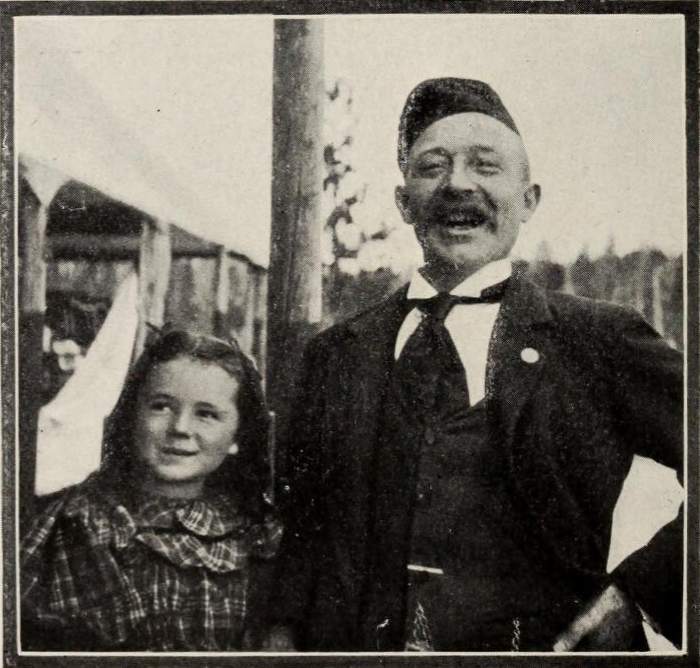
Before Yellowstone
According to historian Robert “Geyser Bob” V. Goss—citing research conducted by Elizabeth A. Watry, author of Women In Wonderland—Matthews was born Larry McMahon in Drogheda, Ireland in 1854, emigrating to the States in 1882, moving to Minneapolis, Minnesota. He reportedly changed his name to seem “less Irish.” In 1886, he married Bridget Clinton; a year later he took a post out in Yellowstone. His only daughter Elizabeth (affectionately known as “Lizzie”) was born in 1891. You can see a photo of Matthews and Lizzie above at Norris.
“Good Luck Go With Larry!”
Matthews had been in the Park prior to the establishment of his Norris hotspot. Indeed, the Norris location was his third “Lunch Station.” The first was built at Trout Creek in 1888, along the old road that took visitors between Canyon and Lake. Matthews managed it for the Yellowstone Park Association. You can see a sketch of it below.
Matthews’ marketable personality was apparently already in full bloom at this point, if we’re to believe British writer Rudyard Kipling, who mentioned him in a long article about his trip to Yellowstone National Park, recounted dining at “Larry’s” Trout Creek joint in 1889, a little over a year after its establishment. Indeed, Kipling notes how their party, after arriving “disheveled” along the “new-made road” through the Hayden Valley, found reprieve at Larry’s Lunch Station:
Only “Larry” could have managed that school-feast tent on the lonely hillside. Need I say that he was an Irishman? His supplies were at their lowest ebb, but Larry enveloped us all in the golden glamour of his speech ere we had descended, and the tent with the rude trestle-table became a palace, the rough fare, delicacies of Delmonico, and we, the abashed recipients of Larry’s imperial bounty. It was only later that I discovered I had paid eight shillings for tinned beef, biscuits, and beer, but on the other hand Larry had said: “Will I got out an’ kill a buffalo?” And I felt that for me and for me alone he would have done it. Everybody else felt that way. Good luck go with Larry!”
The Move To Norris
Business apparently dried up in 1892, when a new road was built in the Craig Pass, connecting Old Faithful and West Thumb. Accordingly, the YPA and Matthews moved down to West Thumb, and while the West Thumb station stayed open until 1916, Matthews moved himself and brand further north in 1893. Before that, however, he made one fascinating contribution to Yellowstone marketing.
According to Lee H. Whittlesey, writing in Yellowstone Place Names, in 1892, Matthews posed for Park photographer Frank J. Haynes, who later used the image in a postcard. The postcard, which you can see below, is ingenious for its time, depicting Matthews in chef’s hat and apron, casting out from “Hot Spring Cone” (or “Fishing Cone,” where early visitors liked to parboil trout caught along the shore of Yellowstone Lake).
But moving the lunch station to Norris was, in all likelihood, Matthews’ best business decision, especially given that the Mammoth-Old Faithful corridor was one of the most well-traveled places in the Park.
It didn’t hurt, either, that the area was in need of accommodations since the old Norris Hotel burned down in 1892.
“A Classic Irishman”
As mentioned, although the YPA owned the lunch stations, Larry became, in essence, their avatar, renowned for his wit and ingratiating personality. It’s possible, for instance, that without Matthews, the early Yellowstone lunch stations may not have warranted more than a glance—a quick notice in the brochures saying “oh, by the way, there’s food.”
But, as Whittlesey notes, while the Lunch Station’s meals were reportedly “spartan” (recall Kipling’s assessment) and Matthews himself sometimes joked about the quality, his personality (especially once he had “arrived” at Norris) bore the whole place aloft.
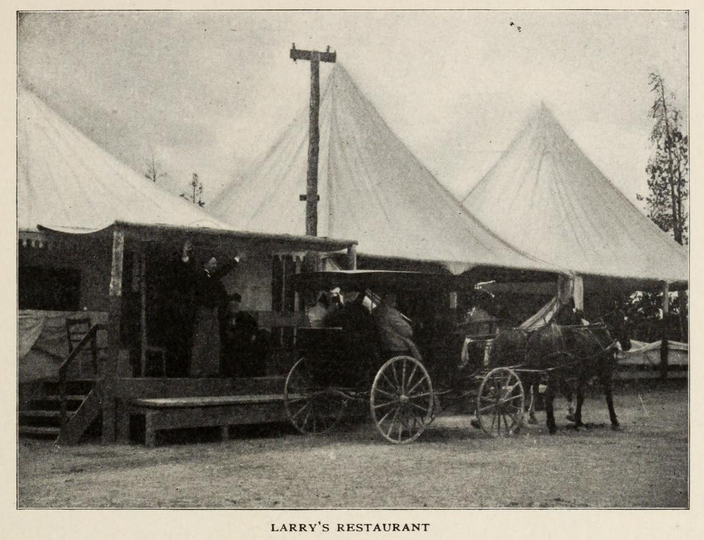
Travelogue writer Burton Holmes, for instance, had a glowing assessment of Matthews and his “Cafay” in his book about touring Yellowstone:
As we drive on, we skirt a number of pretty lakes and finally, at noon, just as the thought of luncheon obtrudes itself, there flash into view the snow-white tents of “Larry’s” famous lunch establishment. What traveler does not remember Larry Matthews and his canvas palace? Who can forget his cheery welcome when, lifting the ladies from the coach, he cries: “Glad to see you! Walk right upstairs,—or would ye rather take the elevator?” And who can forget the honest Irish face of landlord Larry Matthews? His ready wit is remarkable. Every day he is expected to be funny from 11 to 2 o’clock, during which hours he must not only delight the inbound tourists, but carefully avoid repeating himself in the presence of those outward bound who lunch here for a second time.
Holmes cited a few other choice quips from Matthews during their meal service:
• Upon meeting an Italian nicknamed “the Count” by Holmes’ entourage: “Ah, Count, glad to meet you; but you know a dollar’s all that’s a count in this café.”
• Upon being asked for a glass of milk: “Drive in the cow!”
• Upon the fare offered to guests at Larry’s Lunch Station: “There’s no extra charge for flies and dust,—always on the bill-of-fare,—a standing order.”
Sculptor and painter Frederic Remington felt similarly about Larry’s Lunch Station when he visited it in 1893:
As we pulled up in front of the tents of the rest cap, one of those mountain thunder-storms set in, and it was as though the New York fire department had concentrated its nozzles on the earth. The place was presided over by a classic Irishman by the name of Larry, who speedily got a roaring-hot beefsteak and some coffee on the table, and then busied himself conducting growing pools of rain-water out of the tent. Larry is justly famous on the road for his bonhomie and Celtic wit.
After Yellowstone
Although he toiled in Yellowstone in the summer, according to Goss, he held other positions in Canada (“travelling passenger agent” for the Northern Pacific Railroad Company) and Mexico (leading excursions and guiding tourists), all the while working to make Larry’s Lunch Station a memorable destination. However, between 1903 and 1904, he was reportedly given a remarkable move-up, as it were: managing the newly constructed Old Faithful Inn.
Alas, according to Goss, Matthews left the Old Faithful Inn after one year, due to an apparent refusal by the YPA to increase his pay. He never worked in the Park again after that, returning home to Minnesota. He first bought a farm close to his wife’s family before moving north to Crookston (in the northwest corner of the state) be close to his daughter. He passed away in 1922.
 Yellowstone Insider Your Complete Guide to America's First National Park
Yellowstone Insider Your Complete Guide to America's First National Park
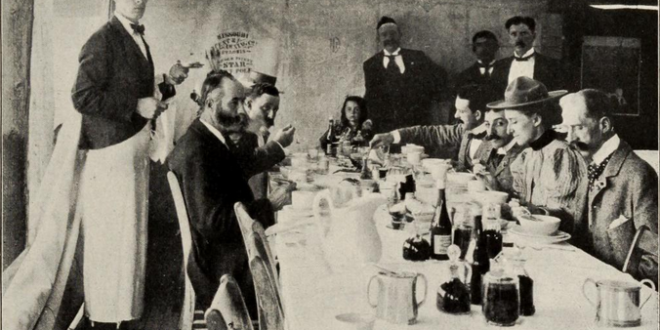
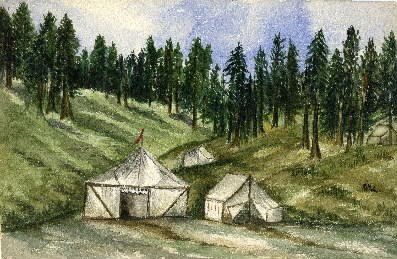
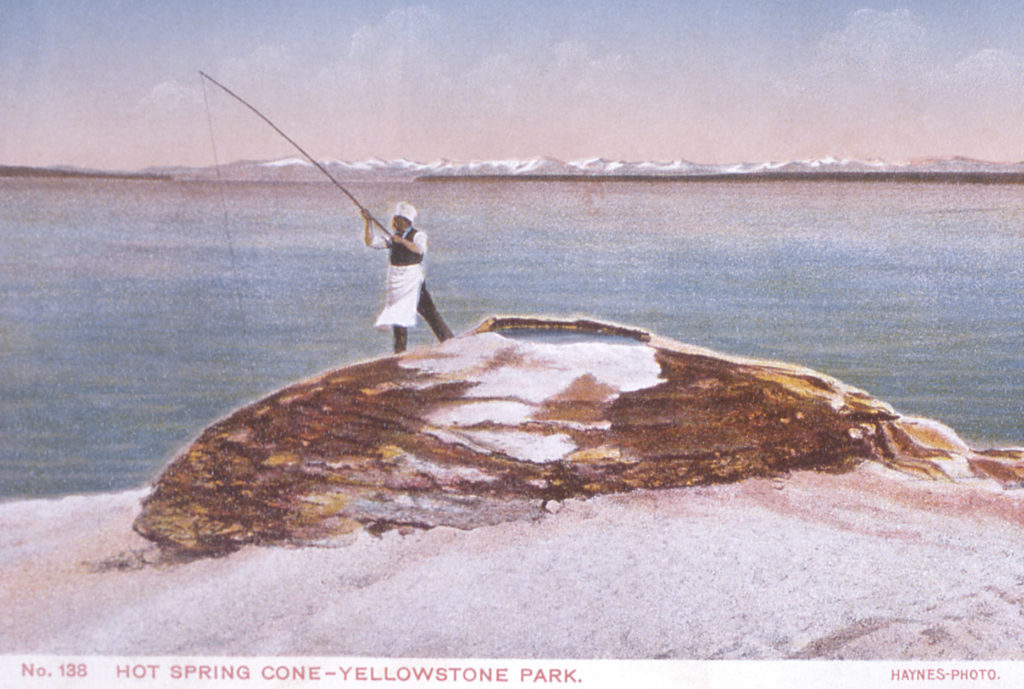




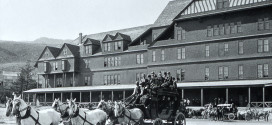
You must be logged in to post a comment.